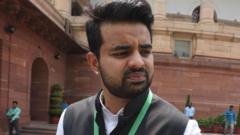**An exploration of the life and legacy of Guru Dutt, whose cinematic genius reflects profound personal struggles, shedding light on the intersection of creativity and mental health.**
**Guru Dutt: A Legacy of Talent and Tragedy in Indian Cinema**

**Guru Dutt: A Legacy of Talent and Tragedy in Indian Cinema**
**Embodying the struggles of an artist, Guru Dutt's brilliance continues to echo in Indian film history.**
Guru Dutt, a beloved figure in Indian cinema, left a lasting impact through his hauntingly beautiful films, notably Pyaasa and Kaagaz Ke Phool. As we approach the centenary of his birth on July 9, 2025, reflections on his life reveal a complex tapestry of artistic brilliance intertwined with deep personal turmoil. Born in Karnataka on July 9, 1925, Dutt's journey to becoming a cinematic icon was marked by financial struggles and emotional hardship, which profoundly influenced his work.
Dutt began his film career as a choreographer in the Bombay film industry during the 1940s, transitioning into directing after the influential noir thriller, Baazi, in 1951 marked his arrival. His early years in the spotlight included a love affair with the celebrated singer Geeta Roy, and while it was a time of gratitude, it also foreshadowed the emotional conflicts that would shape his later works.
His film Pyaasa, released in 1957, not only marked a critical turning point, but also explored themes such as societal disillusionment and the struggles of the artist. The film portrayed an artist’s grappling with materialism, becoming an enduring piece of work and recognized by Time magazine as one of the 20th century's greatest films. However, behind the scenes, Dutt's pursuit for perfection, noted in his meticulous attention to production, began to take a toll on his mental health. The emotional depths faced during the making of Pyaasa included Dutt's disturbing descent into dependence on alcohol and sleeping pills.
Dutt’s persistence with personal storytelling heightened during the making of Kaagaz Ke Phool, a film reflecting a filmmaker's strained relationships, including a troubled marriage, which was a commercial flop despite its current acclaim. Dutt's artistry clashed severely with his personal life and unresolved mental health issues, eventually leading to attempts at self-harm. Friends and family, including his sister Lalitha Lajmi, recognized symptoms of deep emotional distress but were unable to seek proper support due to societal stigma against mental health issues at the time.
After a brief period of recovery, Dutt returned to cinema as a producer with successful titles like Sahib Bibi Aur Ghulam, yet his decline continued. Personal relationships worsened, and he battled profound loneliness, often leading him back to alcohol. Despite professional successes, Dutt showed signs of desperation and fear, indicating ongoing struggles with his mental state.
On October 10, 1964, at the age of 39, Guru Dutt’s life came to a tragic end, reflecting the same despair his characters often embodied. His cinematic legacy, while deeply moving, invites us to consider the hidden pains behind artistic expression. Dutt’s story serves as a poignant reminder of the pressures faced by creative individuals, highlighting the importance of addressing mental health in the arts. The depths of his talent resonate profoundly, drawing echoes of what could have been had he lived longer to continue shaping Indian cinema's narrative landscape.
Dutt began his film career as a choreographer in the Bombay film industry during the 1940s, transitioning into directing after the influential noir thriller, Baazi, in 1951 marked his arrival. His early years in the spotlight included a love affair with the celebrated singer Geeta Roy, and while it was a time of gratitude, it also foreshadowed the emotional conflicts that would shape his later works.
His film Pyaasa, released in 1957, not only marked a critical turning point, but also explored themes such as societal disillusionment and the struggles of the artist. The film portrayed an artist’s grappling with materialism, becoming an enduring piece of work and recognized by Time magazine as one of the 20th century's greatest films. However, behind the scenes, Dutt's pursuit for perfection, noted in his meticulous attention to production, began to take a toll on his mental health. The emotional depths faced during the making of Pyaasa included Dutt's disturbing descent into dependence on alcohol and sleeping pills.
Dutt’s persistence with personal storytelling heightened during the making of Kaagaz Ke Phool, a film reflecting a filmmaker's strained relationships, including a troubled marriage, which was a commercial flop despite its current acclaim. Dutt's artistry clashed severely with his personal life and unresolved mental health issues, eventually leading to attempts at self-harm. Friends and family, including his sister Lalitha Lajmi, recognized symptoms of deep emotional distress but were unable to seek proper support due to societal stigma against mental health issues at the time.
After a brief period of recovery, Dutt returned to cinema as a producer with successful titles like Sahib Bibi Aur Ghulam, yet his decline continued. Personal relationships worsened, and he battled profound loneliness, often leading him back to alcohol. Despite professional successes, Dutt showed signs of desperation and fear, indicating ongoing struggles with his mental state.
On October 10, 1964, at the age of 39, Guru Dutt’s life came to a tragic end, reflecting the same despair his characters often embodied. His cinematic legacy, while deeply moving, invites us to consider the hidden pains behind artistic expression. Dutt’s story serves as a poignant reminder of the pressures faced by creative individuals, highlighting the importance of addressing mental health in the arts. The depths of his talent resonate profoundly, drawing echoes of what could have been had he lived longer to continue shaping Indian cinema's narrative landscape.

















